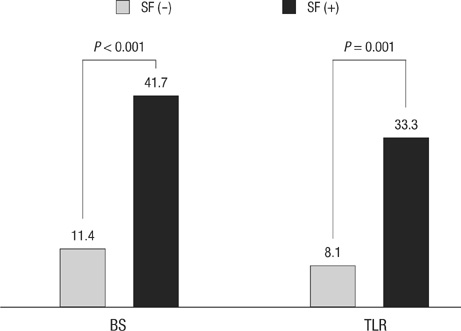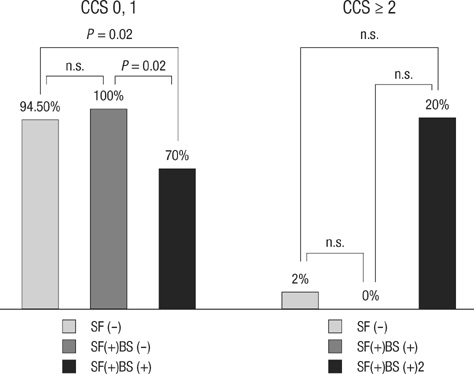J Korean Med Sci.
2011 Jan;26(1):53-58. 10.3346/jkms.2011.26.1.53.
Clinical Characteristics of Coronary Drug-Eluting Stent Fracture: Insights from a Two-Center DES Registry
- Affiliations
-
- 1Department of Internal Medicine and Cardiovascular Center, Seoul National University Hospital, Seoul, Korea.
- 2Department of Internal Medicine and Cardiovascular Center, Seoul National University Bundang Hospital, Seongnam, Korea. djchoi@snubh.org
- 3Department of Internal Medicine, Boramae Medical Center, Seoul, Korea.
- KMID: 1777976
- DOI: http://doi.org/10.3346/jkms.2011.26.1.53
Abstract
- Stent fracture (SF) has been implicated as a risk factor for in-stent restenosis, but its incidence and clinical characteristics are not well established. Therefore we investigated the conditions associated with stent fracture and its clinical presentation and outcome. Between 2004 and 2007, consecutive cases of SF were collected from the Seoul National University Hospital. Clinical characteristics and outcome of patients with fractured stents were compared with a ten-fold cohort of age and gender matched controls (n = 236). A total of 4,845 patients received percutaneous coronary intervention and 3,315 patients (68.4%) underwent angiographic follow-up. Twenty-eight fractured stents were observed in 24 patients. The incidence of SF was 0.89% for sirolimus-eluting stents (SES) and 0.09% for paclitaxel-eluting stents. Chronic kidney disease, stent implantation in the right coronary artery (RCA), and SES use were independent predictors of drug-eluting stent fracture by multivariate analysis. SF was significantly associated with binary restenosis (11.4% vs 41.7%, P < 0.001) and increased risk of target lesion revascularization (8.1% vs 33.3%, P = 0.001). Patients with SF but without significant restenosis showed excellent outcome despite only medical treatment. In conclusion, SF is associated with increased rates of restenosis and repeat revascularization. Significant risk factors include chronic kidney disease, RCA intervention, and SES use.
Keyword
MeSH Terms
-
Age Factors
Aged
Cardiovascular Agents/administration & dosage
Cohort Studies
Coronary Angiography
Coronary Restenosis/diagnosis/*epidemiology/prevention & control
Coronary Stenosis/radiography/therapy
*Drug-Eluting Stents
Female
Humans
Male
Middle Aged
Paclitaxel/administration & dosage
*Prosthesis Failure
Registries
Risk Factors
Sex Factors
Sirolimus/administration & dosage
Figure
Reference
-
1. Shaikh F, Maddikunta R, Djelmami-Hani M, Solis J, Allaqaband S, Bajwa T. Stent fracture, an incidental finding or a significant marker of clinical in-stent restenosis? Catheter Cardiovasc Interv. 2008. 71:614–618.2. Betriu A, Masotti M, Serra A, Alonso J, Fernández-Avilés F, Gimeno F, Colman T, Zueco J, Delcan JL, Garcia E, Calabuig J. Randomized comparison of coronary stent implantation and balloon angioplasty in the treatment of de novo coronary artery lesions (START): a four-year follow-up. J Am Coll Cardiol. 1999. 34:1498–1506.3. Al Suwaidi J, Holmes DR Jr, Salam AM, Lennon R, Berger PB. Impact of coronary artery stents on mortality and nonfatal myocardial infarction: meta-analysis of randomized trials comparing a strategy of routine stenting with that of balloon angioplasty. Am Heart J. 2004. 147:815–822.4. Bae JH, Hyun DW, Kim KY, Yoon HJ, Nakamura S. Drug-eluting stent strut fracture as a cause of restenosis. Korean Circ J. 2005. 35:787–789.5. Lee SH, Park JS, Shin DG, Kim YJ, Hong GR, Kim W, Shim BS. Frequency of stent fracture as a cause of coronary restenosis after sirolimus-eluting stent implantation. Am J Cardiol. 2007. 100:627–630.6. Doi H, Maehara A, Mintz GS, Tsujita K, Kubo T, Castellanos C, Liu J, Yang J, Oviedo C, Aoki J, Franklin-Bond T, Dasgupta N, Lansky AJ, Dangas GD, Stone GW, Moses JW, Mehran R, Leon MB. Classification and potential mechanisms of intravascular ultrasound patterns of stent fracture. Am J Cardiol. 2009. 103:818–823.7. Jaff M, Dake M, Pompa J, Ansel G, Yoder T. Standardized evaluation and reporting of stent fractures in clinical trials of noncoronary devices. Catheter Cardiovasc Interv. 2007. 70:460–462.8. Yang TH, Kim DI, Park SG, Seo JS, Cho HJ, Seol SH, Kim SM, Kim DK, Kim DS. Clinical characteristics of stent fracture after sirolimus-eluting stent implantation. Int J Cardiol. 2009. 131:212–216.9. Umeda H, Gochi T, Iwase M, Izawa H, Shimizu T, Ishiki R, Inagaki H, Toyama J, Yokota M, Murohara T. Frequency, predictors and outcome of stent fracture after sirolimus-eluting stent implantation. Int J Cardiol. 2009. 133:321–326.10. Sianos G, Hofma S, Ligthart JM, Saia F, Hoye A, Lemos PA, Serruys PW. Stent fracture and restenosis in the drug-eluting stent era. Catheter Cardiovasc Interv. 2004. 61:111–116.11. Kim EJ, Rha SW, Wani SP, Suh SY, Choi CU, Kim JW, Park CG, Seo HS, Oh DJ. Coronary stent fracture and restenosis in the drug-eluting stent era: do we have clues of management? Int J Cardiol. 2007. 120:417–419.12. Lee HS, Hur SH, Nam CW, Cho YK, Kim H, Han SW, Kim KB, Kim YN. A case of stent strut fracture of a paclitaxel-eluting stent at the time of sent implantation in a complex coronary lesion. Korean Circ J. 2008. 38:387–389.13. Lee MS, Jurewitz D, Aragon J, Forrester J, Makkar RR, Kar S. Stent fracture associated with drug-eluting stents: clinical characteristics and implications. Catheter Cardiovasc Interv. 2007. 69:387–394.14. Makaryus AN, Lefkowitz L, Lee AD. Coronary artery stent fracture. Int J Cardiovasc Imaging. 2007. 23:305–309.15. Park JS, Cho IH, Kim YJ. Stent fracture and restenosis after zotarolimus-eluting stent implantation. Int J Cardiol. 2009. doi:10.1016/j.ijcard.2009.01.030.16. Chung WS, Park CS, Seung KB, Kim PJ, Lee JM, Koo BK, Jang YS, Yang JY, Yoon JH, Kim DI, Yoon YW, Park JS, Cho YH, Park SJ. The incidence and clinical impact of stent strut fractures developed after drug-eluting stent implantation. Int J Cardiol. 2008. 125:325–331.17. Kim HS, Kim YH, Lee SW, Park DW, Lee CW, Hong MK, Park SW, Ko JK, Park JH, Lee JH, Choi SW, Seong IW, Cho YH, Lee NH, Kim JH, Chun KJ, Park SJ. Long-DES-II study investigators. Incidence and predictors of drug-eluting stent fractures in long coronary disease. Int J Cardiol. 2009. 133:354–358.18. Canan T, Lee MS. Drug-eluting stent fracture: incidence, contributing factors, and clinical implications. Catheter Cardiovasc Interv. 2010. 75:237–245.19. Liao R, Green NE, Chen SY, Messenger JC, Hansgen AR, Groves BM, Carroll JD. Three-dimensional analysis of in vivo coronary stent--coronary artery interactions. Int J Cardiovasc Imaging. 2004. 20:305–313.20. Nakazawa G, Finn AV, Vorpahl M, Ladich E, Kutys R, Balazs I, Kolodgie FD, Virmani R. Incidence and predictors of drug-eluting stent fracture in human coronary artery a pathologic analysis. J Am Coll Cardiol. 2009. 54:1924–1931.
- Full Text Links
- Actions
-
Cited
- CITED
-
- Close
- Share
- Similar articles
-
- Two Cases of Immediate Stent Fracture after Zotarolimus-Eluting Stent Implantation
- Dark Side of Drug-eluting Stent in Contemporary Percutaneous Coronary Intervention
- Drug-Eluting Stent Strut Fracture as a Cause of Restenosis
- A Case of Stent Strut Fracture of a Paclitaxel-Eluting Stent at the Time of Stent Implantation in a Complex Coronary Lesion
- Stent Thrombosis in the Era of the Drug-Eluting Stent



